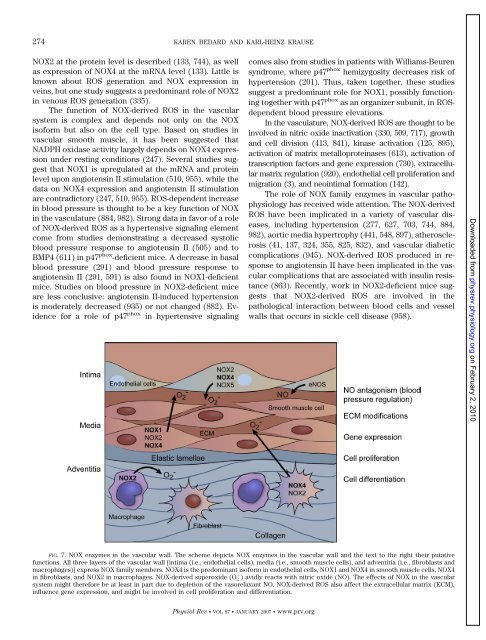Karen Bedard and Karl-Heinz Krause
Karen Bedard and Karl-Heinz Krause
Karen Bedard and Karl-Heinz Krause
Create successful ePaper yourself
Turn your PDF publications into a flip-book with our unique Google optimized e-Paper software.
274 KAREN BEDARD AND KARL-HEINZ KRAUSE<br />
NOX2 at the protein level is described (133, 744), as well<br />
as expression of NOX4 at the mRNA level (133). Little is<br />
known about ROS generation <strong>and</strong> NOX expression in<br />
veins, but one study suggests a predominant role of NOX2<br />
in venous ROS generation (335).<br />
The function of NOX-derived ROS in the vascular<br />
system is complex <strong>and</strong> depends not only on the NOX<br />
isoform but also on the cell type. Based on studies in<br />
vascular smooth muscle, it has been suggested that<br />
NADPH oxidase activity largely depends on NOX4 expression<br />
under resting conditions (247). Several studies suggest<br />
that NOX1 is upregulated at the mRNA <strong>and</strong> protein<br />
level upon angiotensin II stimulation (510, 955), while the<br />
data on NOX4 expression <strong>and</strong> angiotensin II stimulation<br />
are contradictory (247, 510, 955). ROS-dependent increase<br />
in blood pressure is thought to be a key function of NOX<br />
in the vasculature (884, 982). Strong data in favor of a role<br />
of NOX-derived ROS as a hypertensive signaling element<br />
come from studies demonstrating a decreased systolic<br />
blood pressure response to angiotensin II (505) <strong>and</strong> to<br />
BMP4 (611) in p47 phox -deficient mice. A decrease in basal<br />
blood pressure (291) <strong>and</strong> blood pressure response to<br />
angiotensin II (291, 591) is also found in NOX1-deficient<br />
mice. Studies on blood pressure in NOX2-deficient mice<br />
are less conclusive: angiotensin II-induced hypertension<br />
is moderately decreased (935) or not changed (882). Evidence<br />
for a role of p47 phox in hypertensive signaling<br />
comes also from studies in patients with Williams-Beuren<br />
syndrome, where p47 phox hemizygosity decreases risk of<br />
hypertension (201). Thus, taken together, these studies<br />
suggest a predominant role for NOX1, possibly functioning<br />
together with p47 phox as an organizer subunit, in ROSdependent<br />
blood pressure elevations.<br />
In the vasculature, NOX-derived ROS are thought to be<br />
involved in nitric oxide inactivation (330, 509, 717), growth<br />
<strong>and</strong> cell division (413, 841), kinase activation (125, 895),<br />
activation of matrix metalloproteinases (613), activation of<br />
transcription factors <strong>and</strong> gene expression (730), extracellular<br />
matrix regulation (920), endothelial cell proliferation <strong>and</strong><br />
migration (3), <strong>and</strong> neointimal formation (142).<br />
The role of NOX family enzymes in vascular pathophysiology<br />
has received wide attention. The NOX-derived<br />
ROS have been implicated in a variety of vascular diseases,<br />
including hypertension (277, 627, 703, 744, 884,<br />
982), aortic media hypertrophy (441, 548, 897), atherosclerosis<br />
(41, 137, 324, 355, 825, 832), <strong>and</strong> vascular diabetic<br />
complications (945). NOX-derived ROS produced in response<br />
to angiotensin II have been implicated in the vascular<br />
complications that are associated with insulin resistance<br />
(863). Recently, work in NOX2-deficient mice suggests<br />
that NOX2-derived ROS are involved in the<br />
pathological interaction between blood cells <strong>and</strong> vessel<br />
walls that occurs in sickle cell disease (958).<br />
FIG. 7. NOX enzymes in the vascular wall. The scheme depicts NOX enzymes in the vascular wall <strong>and</strong> the text to the right their putative<br />
functions. All three layers of the vascular wall [intima (i.e., endothelial cells), media (i.e., smooth muscle cells), <strong>and</strong> adventitia (i.e., fibroblasts <strong>and</strong><br />
macrophages)] express NOX family members. NOX4 is the predominant isoform in endothelial cells, NOX1 <strong>and</strong> NOX4 in smooth muscle cells, NOX4<br />
in fibroblasts, <strong>and</strong> NOX2 in macrophages. NOX-derived superoxide (O 2 � ) avidly reacts with nitric oxide (NO). The effects of NOX in the vascular<br />
system might therefore be at least in part due to depletion of the vasorelaxant NO. NOX-derived ROS also affect the extracellular matrix (ECM),<br />
influence gene expression, <strong>and</strong> might be involved in cell proliferation <strong>and</strong> differentiation.<br />
Physiol Rev VOL 87 JANUARY 2007 www.prv.org<br />
Downloaded from<br />
physrev.physiology.org<br />
on February 2, 2010













